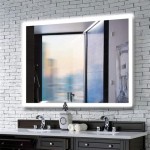Mirroring a Windows 7 Laptop to a Samsung Smart TV
Mirroring a laptop screen to a Samsung Smart TV can significantly enhance how presentations are delivered, entertainment is consumed, and collaborations are conducted. While Windows 7 is an older operating system, several methods exist to achieve this functionality, enabling users to leverage the larger display of their Smart TV. This article outlines various technical approaches, required hardware and software components, troubleshooting tips, and important considerations for successfully mirroring a Windows 7 laptop to a Samsung Smart TV.
The primary challenge lies in the fact that Windows 7 does not natively support Miracast, the wireless display standard that many modern Smart TVs utilize. Therefore, users must explore alternative solutions involving wired connections, third-party software, or potentially hardware upgrades to bridge this compatibility gap.
Understanding the Limitations of Windows 7
Windows 7 was released before the widespread adoption of wireless display technologies like Miracast and WiDi. These technologies allow devices to transmit their screens wirelessly to compatible displays without needing physical cables. Because Windows 7 does not include built-in support for these protocols, directly connecting wirelessly to a Miracast-enabled Samsung Smart TV is not possible without additional software or hardware.
The absence of native Miracast support necessitates the exploration of other, potentially more cumbersome, mirroring options. This may involve utilizing HDMI cables, installing screen-sharing software, or investigating hardware solutions that introduce Miracast capabilities to the Windows 7 system.
Exploring Wired Connection Options: HDMI
The most reliable and straightforward method for mirroring a Windows 7 laptop to a Samsung Smart TV is using an HDMI (High-Definition Multimedia Interface) cable. HDMI is a standard digital interface that transmits both audio and video signals from a source device (the laptop) to a display device (the Smart TV). This method bypasses the limitations of wireless compatibility, providing a direct and high-quality connection.
To utilize this approach, the following steps should be considered. First, locate the HDMI port on the Windows 7 laptop and on the Samsung Smart TV. Typically, laptops will have one or more HDMI outputs, while Smart TVs will have several HDMI inputs. Identify the desired input number on the TV, as this will need to be selected later. Connect one end of the HDMI cable to the laptop's HDMI port and the other end to the chosen HDMI port on the Smart TV.
Next, power on both the laptop and the Smart TV. Using the TV remote, navigate to the input selection menu. This menu is usually labeled "Source," "Input," or something similar. Select the HDMI input number that corresponds to the port where the laptop is connected. The laptop screen should now be mirrored on the Smart TV. Display settings may need to be adjusted on the Windows 7 laptop. This can be done by right-clicking on the desktop, selecting "Screen Resolution," and choosing the desired display mode (e.g., "Duplicate," "Extend," or "Show desktop only on"). The "Duplicate" option will mirror the laptop screen, while "Extend" will treat the TV as a second monitor, allowing the user to drag windows between the two displays.
Potential issues with HDMI connections can include no signal being detected, incorrect resolution, or audio problems. If no signal is detected, ensure the HDMI cable is securely connected to both devices and that the correct input source is selected on the TV. If the resolution is incorrect, adjust the display settings on the laptop to match the TV's native resolution. If audio is not being transmitted, check the sound settings on both the laptop and the TV to ensure the correct audio output device is selected.
Utilizing Third-Party Screen-Sharing Software
While not a native solution, third-party screen-sharing software can offer a wireless mirroring experience for Windows 7 users. Several applications are available that install on both the laptop and the Smart TV (or a device connected to the Smart TV, such as a streaming stick) and facilitate screen mirroring over a Wi-Fi network.
Examples of such software include Plex, AirParrot, and similar applications. The specific steps will vary depending on the chosen software, but the general process involves downloading and installing the software on both the Windows 7 laptop and a compatible device connected to the Samsung Smart TV (e.g., a Roku, Chromecast, or an app directly on the Smart TV if supported). After installation, the software needs to be configured to connect the laptop to the TV. This typically involves entering a code or password displayed on the TV into the software on the laptop, or vice versa. Once connected, the laptop screen should be mirrored on the TV.
The primary advantages of this method are the wireless convenience and the potential for advanced features like remote control and file sharing, it relies on the stability of the Wi-Fi network. A weak or congested Wi-Fi signal can lead to lag, buffering, and a poor mirroring experience. Also, these programs may have subscription based payment models.
It is essential to research and choose software that is compatible with both Windows 7 and the Samsung Smart TV. Some software may require specific hardware configurations or operating system updates. Thoroughly reading reviews and testing the software before committing to a purchase is recommended.
Exploring Hardware Solutions: Wireless Display Adapters
Another possible solution for mirroring a Windows 7 laptop to a Samsung Smart TV involves using a wireless display adapter. These devices plug into the TV's HDMI port and create a wireless connection point that the laptop can connect to. Many of these adapters utilize the Miracast standard, but they act as a bridge between the Windows 7 laptop and the TV.
Devices such as the Microsoft Wireless Display Adapter, and similar products from other manufacturers, can be used for this purpose. The setup process generally involves plugging the adapter into the TV's HDMI port and a USB port for power. Following the manufacturer's instructions for connecting the adapter to the Wi-Fi network is essential.
Because Windows 7 does not natively support Miracast, an additional step is needed to connect the laptop to the adapter. Usually, this involves installing specific software or drivers provided by the adapter's manufacturer. The software should enable the laptop to detect and connect to the wireless display adapter. Once connected, the laptop screen should be mirrored on the TV.
This method offers a relatively simple way to add wireless mirroring capabilities to a Windows 7 laptop. However, compatibility with the adapter's software and the Windows 7 operating system must be verified before purchasing. The performance of the wireless connection can also be affected by the distance between the laptop and the adapter, as well as interference from other wireless devices.
The selection of adapters depends on the needs of the user. Cheaper adapters may not have as reliable hardware. This, therefore, may influence the decision of the user on what to buy.
Troubleshooting Common Mirroring Issues
When mirroring a Windows 7 laptop to a Samsung Smart TV, several common issues can arise. Addressing these issues systematically can help ensure a smooth and successful mirroring experience.
One common problem is the lack of a video signal. If the TV displays a "No Signal" message, the issue could be with the HDMI cable (if using a wired connection), the input source selection on the TV, or the laptop's display settings. Verifying that the HDMI cable is securely connected to both devices, selecting the correct HDMI input on the TV, and adjusting the laptop's display settings to "Duplicate" or "Extend" are essential steps. Restarting both the laptop and the TV can also help resolve this issue.
Another frequent issue is poor video quality or lag. This can be caused by a weak Wi-Fi signal (if using a wireless connection), outdated graphics drivers on the laptop, or insufficient processing power. Ensuring a strong Wi-Fi signal, updating the graphics drivers to the latest version, and closing unnecessary applications on the laptop can improve the video quality and reduce lag. Lowering the resolution of the laptop's display can also help, especially if the laptop has limited processing power.
Audio problems are also common when mirroring. If there is no sound coming from the TV, verify that the correct audio output device is selected on both the laptop and the TV. In the Windows 7 sound settings, ensure that the HDMI output is selected as the default audio device. On the TV, check the audio settings to ensure that the correct input source is selected and that the volume is not muted. If using screen-sharing software, verify that the audio settings within the software are configured correctly.
Compatibility issues can also arise, especially when using third-party software or wireless display adapters. Before installing any software or purchasing any hardware, verify that it is compatible with both Windows 7 and the Samsung Smart TV. Check the manufacturer's website for compatibility information and download the latest drivers or software updates.
Finally, firewall settings can sometimes interfere with screen-sharing software. Ensure that the firewall on the Windows 7 laptop is not blocking the software's connection to the TV. Temporarily disabling the firewall (for testing purposes only) can help determine if it is the cause of the problem.

Access Your Pc Remotely On Samsung Qled Tv Or Smart Monitor

How To Connect Your Pc Samsung Smart Tv Through Screen Mirroring

How To Connect Samsung Smart Tv Laptop Wirelessly Very Easily

Samsung Screen Mirroring With Laptop

How To Screen Mirror Laptop Tv Samsung

Access Your Pc Remotely On Samsung Qled Tv Or Smart Monitor

How To Connect Mirror Laptop Screen On Samsung Smart Tv Wire Wirelessly

What Is Screen Mirroring And How Do I Use It With My Samsung Tv Mobile Device

How To Connect Mirror Laptop Screen On Any Smart Tv Wirelessly No App

Smart Tv Screen Mirror








